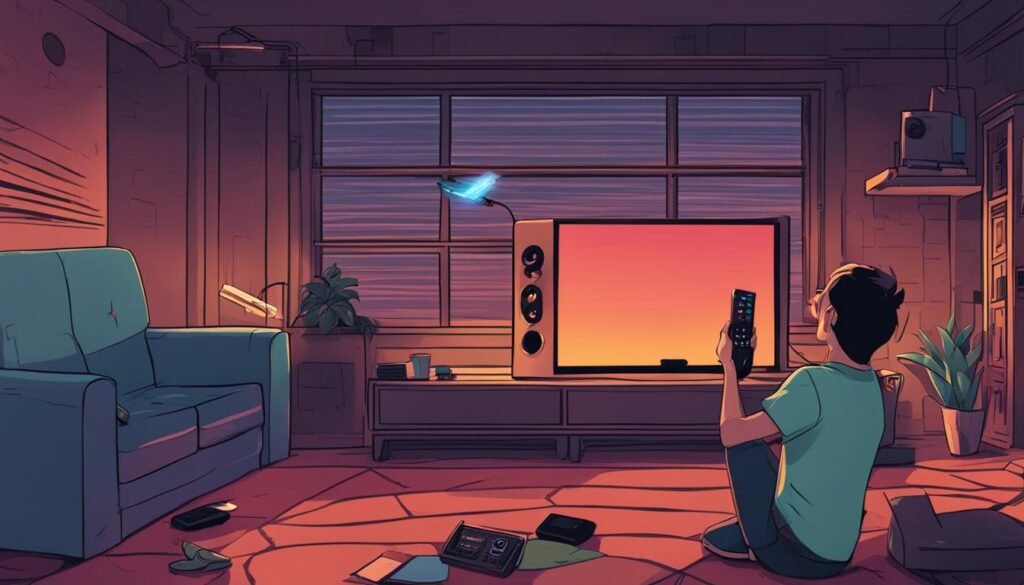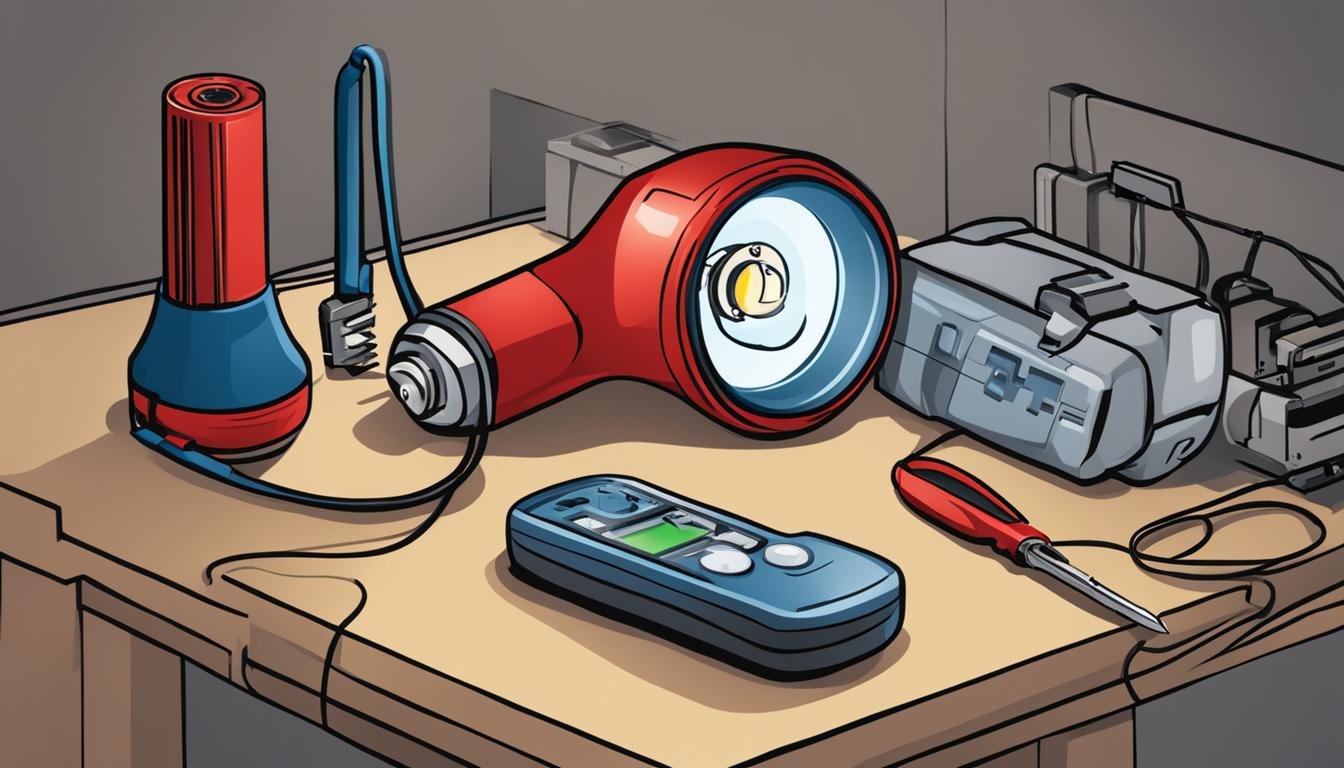LED lights remote controls are a convenient way to manage your low voltage LED strip lights. However, there may be instances when your remote control stops working properly, leaving you in the dark. Don’t fret! In this article, we will provide you with troubleshooting tips and solutions to help you get your LED lights remote back up and running.
Key Takeaways:
- Battery issues can often be the culprit behind a malfunctioning LED lights remote. Make sure to insert fresh batteries and clean the battery contacts regularly.
- Troubleshooting unpairing and programming issues can help restore functionality to your LED lights remote. Resetting and re-pairing the remote control, as well as reprogramming the LED controller, can usually do the trick.
- Signal interference can disrupt the communication between your remote control and LED lights. Adjusting the LED controller receiver and minimizing interference sources can help resolve this problem.
- Range issues may occur if you operate the remote control outside of its effective range. Stick within the recommended range and remove any obstructions for optimal performance.
- If all else fails, a broken remote chip could be the issue. Contact the manufacturer for repair or consider purchasing a new remote control.
By following these troubleshooting tips and solutions, you can overcome common LED lights remote control problems and enjoy the convenience and ambiance of your LED lights once again.
Common Battery Issues with LED Lights Remotes
When it comes to troubleshooting LED lights remotes, one of the most common issues users encounter is related to batteries. Over time, the batteries in the remote control can lose their charge or become depleted, resulting in an ineffective power supply for the LED lights. This can lead to the remote control not working properly or not working at all.
To fix this problem, start by properly inserting fresh batteries into the remote control. Make sure the positive (+) and negative (-) ends of the batteries are correctly aligned with the corresponding terminals in the remote. It’s also a good idea to check the battery contacts in the remote for any dirt or dust buildup.
If you notice any dirt or dust on the battery contacts, gently clean them with a dry cloth or cotton swab. This will help ensure a proper flow of electrical current between the batteries and the remote control, improving its overall performance. By addressing battery issues and maintaining a clean connection, you can enhance the functionality of your LED lights remote control.
Troubleshooting Remote Pairing and Programming Issues
When your LED lights remote becomes unresponsive or fails to work properly, it can be frustrating. However, there are steps you can take to troubleshoot and fix these pairing and programming issues.
Resetting and Reprogramming
If your LED lights remote is not responding to button presses or showing erratic behavior, try resetting and reprogramming it. First, disconnect the power supply to the LED controller and wait for a few seconds. Then, reconnect the power supply and press and hold the reset button on the controller for about 5 seconds. This will reset the pairing between the remote control and the LED lights receiver.
Next, you will need to reprogram the LED controller. Refer to the user manual or instructions provided with your LED lights kit for specific programming steps. Typically, this involves entering a specific sequence of button presses on the remote control to establish a new pairing with the LED lights receiver. Ensure that the remote control and receiver are within the recommended range during the reprogramming process.
Checking Batteries
Another troubleshooting step to consider is checking the batteries in your LED lights remote control. Weak or depleted batteries can cause the remote control to not function properly. Replace the batteries with fresh ones and ensure they are inserted correctly, following the polarity markings. This simple step can often resolve issues with unresponsive remotes.
By following these troubleshooting tips, you can address remote pairing and programming issues and restore functionality to your LED lights remote control. Remember to consult the user manual or seek manufacturer support for specific troubleshooting instructions if needed. Now that you have resolved these issues, let’s move on to the next section on dealing with signal interference and how to fix it.
Dealing with Signal Interference
Signal interference can be a frustrating issue when it comes to LED lights remote control problems. Sometimes, the signals from other devices using similar frequencies can disrupt the communication between the remote control and the LED lights. Additionally, physical objects that block the line of sight can also contribute to signal interference.
To fix this problem, there are a few steps you can take. First, try adjusting the LED controller receiver to a different location. Moving it away from other devices or obstructions might help minimize signal interference. You can also try turning off any devices that use similar signals, such as Wi-Fi routers or cordless phones, to see if that improves the signal reception.

By addressing signal interference, you can improve the connection between your LED lights remote control and the LED lights themselves. This should allow you to operate the lights smoothly without any disruptions or delays.
Resolving Range Issues
If you’re experiencing difficulties with your LED lights remote control, specifically issues related to the range, there are a few troubleshooting steps you can take to address the problem. Range issues often occur when the remote control is used from a distance outside of its effective range.
The recommended range for LED lights remote control is typically between 5 to 10 meters. If you’re using the remote control beyond this range, it may not be able to communicate effectively with the LED lights. To resolve range-related problems, try using the remote control within the recommended range.
Additionally, obstructions can also impact the range of the remote control. If there are physical objects blocking the line of sight between the remote control and the LED lights, the signal may not reach its intended destination. Make sure to remove any obstructions that could be interfering with the signal transmission.
Summary:
- Make sure to use the LED lights remote control within the recommended range of 5 to 10 meters.
- Remove any obstructions that may be blocking the line of sight between the remote control and the LED lights.
Addressing a Broken Remote Chip
If your LED lights remote is not working despite trying troubleshooting tips and solutions, it is possible that you are dealing with a broken remote chip. A broken remote chip can occur due to accidental drops, water damage, or excessive wear and tear. When the remote chip is damaged, it can hinder the communication between the remote control and the LED lights, resulting in non-responsiveness.
Unfortunately, handling a broken remote chip requires more than just simple troubleshooting. In this case, it is recommended to contact the manufacturer for repair or consider purchasing a new remote control. The manufacturer will have the expertise and resources to fix or replace the remote chip, ensuring that your LED lights remote control works seamlessly once again.
Remember to keep your remote control safe and in good condition to avoid damage to the remote chip in the future. Always handle it with care, avoid exposure to liquids, and protect it from accidental drops or impacts. Taking these precautions can help prolong the lifespan of your LED lights remote control and prevent any further issues with the remote chip.
Image:
Conclusion
LED lights remote control issues can be frustrating, but with the right troubleshooting tips and solutions, you can get your remote working again. Whether you’re dealing with battery problems, pairing and programming issues, signal interference, range limitations, or a broken remote chip, there are steps you can take to fix the problem.
If your remote control is not working due to battery issues, try inserting fresh batteries and cleaning the battery contacts to ensure a strong electrical connection. For pairing and programming issues, resetting and re-pairing the remote control, as well as reprogramming the LED controller, usually does the trick.
Signal interference can also be a culprit for remote control problems. Adjusting the LED controller receiver and minimizing the use of devices that use similar signals can help reduce interference. Additionally, staying within the recommended range of 5 to 10 meters and removing any obstructions can help resolve range-related issues.
In some cases, a broken remote chip may be the cause of your remote control not working. If accidental drops, water damage, or wear and tear have damaged the chip, contacting the manufacturer for repair or purchasing a new remote control may be necessary.
Remember, with the right troubleshooting steps, you can fix most LED lights remote control problems and enjoy the convenience of controlling your LED lights with ease.
FAQ
Why is my LED lights remote not working?
There are several possible reasons for your LED lights remote not working, including battery issues, pairing and programming problems, signal interference, range limitations, or a broken remote chip.
What are common battery issues with LED lights remotes?
Over time, the batteries in the remote control can lose charge or become depleted. Additionally, dirt and dust can accumulate on the battery contacts, hindering the flow of electrical current. Properly inserting fresh batteries and cleaning the battery contacts can help resolve these issues.
How can I troubleshoot remote pairing and programming issues?
If your LED lights remote becomes unpaired from the receiver or experiences programming issues, you can try resetting and re-pairing the remote control, as well as reprogramming the LED controller, to usually resolve these problems.
How can I deal with signal interference?
Signal interference can disrupt the communication between the remote control and the LED lights. Adjusting the LED controller receiver or turning off devices that use similar signals can help minimize signal interference.
What can I do to resolve range issues?
If you are experiencing range issues, it is important to use the LED lights remote control within its recommended range of 5 to 10 meters and remove any obstructions that may be blocking the signal.
What should I do if my LED lights remote has a broken remote chip?
Accidental drops, water damage, or excessive wear and tear can lead to a broken remote chip. In this case, contacting the manufacturer for repair or purchasing a new remote control may be necessary.

